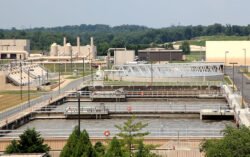
Calumet Water Reclamation Plant
The Calumet Water Reclamation Plant, located in Chicago, Illinois, is one of the largest wastewater treatment facilities in the United States. Serving a population of over two million people, the plant plays a crucial role in protecting the environment and public health by treating wastewater before releasing it back into the waterways. In this article, we will delve into the history of the Calumet Water Reclamation Plant, its function, and its impact on the surrounding community.
History of the Calumet Water Reclamation Plant
The Calumet Water Reclamation Plant was built in the early 1920s to address the growing concerns over pollution in the Chicago River and surrounding water bodies. At the time, raw sewage was being discharged directly into the river, leading to contamination and environmental degradation. The construction of the plant was a significant step towards improving water quality in the region and protecting public health.
Over the years, the plant has undergone several expansions and upgrades to meet the increasing demands of a growing population. Today, it has the capacity to treat up to 300 million gallons of wastewater per day, making it one of the largest facilities of its kind in the country. The plant plays a crucial role in ensuring that the water released back into the environment meets strict quality standards set by regulatory agencies.
Function of the Calumet Water Reclamation Plant
The primary Function of the Calumet Water Reclamation Plant is to treat wastewater before discharging it back into the waterways. The treatment process involves several stages, each designed to remove impurities and pollutants from the water. Here is an overview of the key steps involved in wastewater treatment at the plant:
1. Screening: The first step in the treatment process involves screening the incoming wastewater to remove large debris such as sticks, rocks, and trash. This helps prevent damage to the equipment downstream and ensures that the water is free of any physical contaminants.
2. Primary Treatment: After screening, the wastewater is sent to the primary treatment stage where solid particles are allowed to settle out of the water. This process helps remove a significant portion of the suspended solids and organic matter from the water.
3. Secondary Treatment: The next step in the process involves biological treatment, where microorganisms are used to break down organic pollutants in the water. This helps further reduce the levels of contaminants in the wastewater and improve overall water quality.
4. Tertiary Treatment: In some cases, the plant may also implement tertiary treatment processes to further purify the water. This may involve additional filtration, disinfection, or chemical treatment to remove any remaining impurities and ensure that the water meets regulatory standards.
5. Discharge: Once the wastewater has been treated to the required standards, it is discharged back into the receiving water body, typically a river or lake. The plant closely monitors the quality of the discharged water to ensure that it is not harmful to the environment or public health.
Impact on the Community
The Calumet Water Reclamation Plant plays a critical role in protecting the environment and public health in the Chicago region. By treating wastewater before releasing it back into the waterways, the plant helps prevent pollution and contamination of local water bodies. This, in turn, reduces the risk of waterborne diseases and protects the ecosystem from the harmful effects of untreated sewage.
The plant also has a significant impact on the local economy, providing jobs and supporting businesses in the area. The operation and maintenance of the facility require a skilled workforce, creating employment opportunities for residents in the community. Additionally, the plant contributes to the overall quality of life in the region by ensuring a safe and clean environment for its residents.
In recent years, the Calumet Water Reclamation Plant has implemented several initiatives to improve its environmental performance and sustainability. This includes the use of advanced technologies to optimize the treatment process, reduce energy consumption, and minimize waste generation. The plant has also invested in community outreach and education programs to raise awareness about the importance of water conservation and pollution prevention.
Overall, the Calumet Water Reclamation Plant plays a crucial role in safeguarding public health, protecting the environment, and supporting the economy in the Chicago region. Through its efficient wastewater treatment processes and commitment to sustainability, the plant continues to demonstrate its dedication to promoting a cleaner and healthier future for generations to come.
In conclusion, the Calumet Water Reclamation Plant is a vital infrastructure facility that serves the needs of a large population in the Chicago region. Its role in treating wastewater and protecting the environment cannot be overstated, as it plays a crucial part in ensuring a safe and sustainable water supply for the community. By adhering to strict quality standards and implementing innovative practices, the plant continues to be a leader in the field of wastewater treatment and environmental stewardship.
Sources:
1. Chicago Department of Water Management. Calumet Water Reclamation Plant.” City of Chicago. https://www.chicago.gov/city/en/depts/water/supp_info/calumet-water-reclamation-plant.html
2. Metropolitan Water Reclamation District of Greater Chicago. “Calumet Water Reclamation Plant.” MWRD. https://mwrd.org/calumet_water_reclamation_plant
3. US Environmental Protection Agency. “Wastewater Treatment.” EPA. https://www.epa.gov/wastewater-treatment

